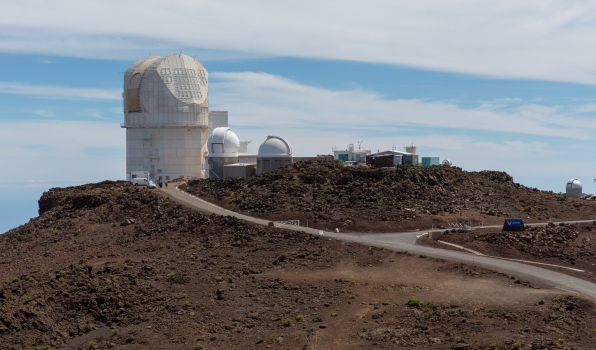General Information
| Other name(s): | DKIST; Advanced Technology Solar Telescope (ATST) |
|---|---|
| Beginning of works: | January 2013 |
| Completion: | December 2019 |
| Status: | in use |
Project Type
| Function / usage: |
Observatory |
|---|---|
| Material: |
Steel structure |
Location
| Location: |
Haleakalā, Maui County, Hawaii, USA |
|---|---|
| Coordinates: | 20° 42' 29.07" N 156° 15' 24.55" W |
Technical Information
There currently is no technical data available.
Excerpt from Wikipedia
The Daniel K. Inouye Solar Telescope (DKIST) is a scientific facility for studies of the Sun under construction at Haleakala Observatory on the Hawaiian island of Maui named after Daniel K. Inouye, a US Senator for Hawaii. With a planned completion date of 2019, it is expected to become the world's largest solar telescope, sporting a 4-meter aperture. The DKIST is funded by National Science Foundation and managed by the National Solar Observatory. Until 2013 it was known as the Advanced Technology Solar Telescope (ATST). It is a collaboration of numerous research institutions.
The DKIST shall be capable of observing the Sun in visible to near-infrared wavelengths and will feature a 4.24-meter primary mirror in an off-axis Gregorian configuration that provides a 4-meter clear, unobstructed aperture. Adaptive optics shall correct for atmospheric schlieren in the solar image known as astronomical seeing to enable high-resolution observations of features on the Sun as small as 20 km (10 mi). The off-axis, clear aperture design avoids a central obstruction, minimizing scattered light. It also eases operation of adaptive optics and digital image reconstruction such as speckle imaging.
The site on the Haleakalā volcano was selected for ist clear daytime weather and favourable atmospheric seeing conditions.
Construction
The contract to build the telescope was awarded in 2010, with a then-planned completion date of 2017. Physical construction at the DKIST site began in January 2013, and work on the telescope housing was completed in September 2013.
The primary mirror was delivered to the site the night of 1–2 August 2017 and as of August 2017 the telescope structure is nearly complete, with first light expected in 2019.
Main telescope structure
The 75 mm thick f/2 primary mirror is a 4.24-meter off-axis section of a 12-meter diameter, f/0.67 concave parabola. It was cast from Zerodur by Schott and polished at the Richard F. Caris Mirror Laboratory of the University of Arizona.
The 0.65-meter secondary mirror, a concave ellipsoid with a focal length of 1 meter, was made from silicon carbide and is mounted on a hexapod to compensate for thermal expansion and bending of the telescope structure keeping the mirror in ist optimal position.
Adaptive and active optics
Instrumentation
DKIST is expected to have five first-generation instruments.
Visible Broadband Imager (VBI)
The VBI is a diffraction-limited two-channel filtergraph each made of an interference filter and a digital scientific CMOS sensor camera that samples the image of the Sun. Each camera features 4k×4k pixels. The interference filters work as a band-pass filter that only transmits a selected wavelength range (i.e. color) of the sunlight. Four different interference filters are available in each channel that are mounted in a motorized fast-change filter wheel.
VBI blue channel (45″ field of view)
- 393.327 nm, FWHM: 0.101 nm (Ca II K spectral line, dark-violet)
- 430.520 nm, FWHM: 0.437 nm (G-band, violet)
- 450.287 nm, FWHM: 0.41 nm (blue continuum)
- 486.139 nm, FWHM: 0.0464 nm (H-beta spectral line, turquoise)
VBI red channel (69″ field of view)
- 656.282 nm, FWHM: 0.049 nm (H-alpha spectral line, light-red)
- 668.423 nm, FWHM: 0.442 nm (red continuum)
- 705.839 nm, FWHM: 0.578 nm (Titanium(II) oxide (TiO) spectral line, dark-red)
- 789.186 nm, FWHM: 0.356 nm (Fe XI spectral line)
Per wavelength, a burst of images shall be recorded with high frame rate (30 fps), digitally analyzed and formed into a single sharpened image (speckle-reconstruction).
VBI is fabricated by the National Solar Observatory.
Visible Spectro-Polarimeter (ViSP)
ViSP is fabricated by the High Altitude Observatory.
Visible Tunable Filter (VTF)
VTF is fabricated by the Kiepenheuer-Institut für Sonnenphysik.
Diffraction-Limited Near-InfraRed Spectro-Polarimeter (DL-NIRSP)
DL-NIRSP is a diffraction grating based integral field spectrograph with a spectral resolution R=250000. DL-NIRSP is fabricated by Institute for Astronomy (IfA) of the University of Hawaii.
Cryogenic Near-InfraRed Spectro-Polarimeter (Cryo-NIRSP)
Cryo-NIRSP is fabricated by Institute for Astronomy (IfA) of the University of Hawaii.
Text imported from Wikipedia article "Daniel K. Inouye Solar Telescope" and modified on July 23, 2019 according to the CC-BY-SA 4.0 International license.
Participants
Relevant Web Sites
Relevant Publications
- (2016): The Moveable Structure of the Dome for the Largest Solar Telescope (DKIST). Presented at: IABSE Congress: Challenges in Design and Construction of an Innovative and Sustainable Built Environment, Stockholm, Sweden, 21-23 September 2016, pp. 2719-2726.
- About this
data sheet - Structure-ID
20072130 - Published on:
13/11/2016 - Last updated on:
01/09/2020





